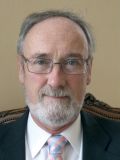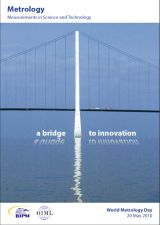|
Message from the Director of the BIPM
World Metrology Day – 20May 2010 |
||||||||||||
|
MEASUREMENTS IN SCIENCE AND TECHNOLOGY
…a bridge to innovation
There is no doubt that metrology and science are interlinked and that the ability to make a better measurement opens up new opportunities. One only has to think of the invention of the laser: a dramatic advance in physics, but an equally dramatic innovation in metrology, so that it was possible to make accurate interferometric distance measurements of up to several kilometres, as well as giving us the ability, eventually, to redefine the metre. Curiously enough, and by one of the accidents of timing, the first publication, of observation of laser action, by Mainman, was made in the year that the international prototype metre was replaced by a definition based on radiation from a krypton lamp. It was, however, another 23 years before the krypton lamp was replaced by a definition based on the speed of light - effectively made possible by the laser. The links between excellent and innovative science and metrology are underscored by the list of Nobel Prize winners- particularly in physics – who saw one of the earliest applications of their discoveries and achievements in metrology. Some have lent their names to metrologically related phenomena: Ramsay fringes in atomic clocks, Josephson junctions in electrical metrology, and the von Klitzing constant in resistance measurements, to name but a few. The National Institute of Standards and Technology in the USA is also fortunate enough to have three recent Nobel Prize winners on its staff: Eric Cornell, John Hall, and Bill Phillips. As research metrologists, that sense of scientific challenge is always with us. Can you remember that thrill when you saw something relevant and special, perhaps for the first time? It’s a curious sensation – shared, I suppose with all researchers – when nature opens up it secrets to us and we can suddenly make an advance which previously eluded or thwarted us, one which then seems almost common place when we have mastered it. However one particular additional sense of satisfaction, not always so obvious a characteristic of the world of our academic colleagues, derives from the fact that that we are generally working in an application driven area. Someone wants a better measurement of this or that; someone else wants a new way to open up SI- traceable measurement possibilities in a new area of chemistry or medicine.
We have a sound and successful track record of achievement in physics and engineering and are building a real reputation in the newer areas of inorganic and organic chemistry, the biosciences, healthcare and environmental measurement …, but more of this next year when we shall also celebrate World Chemistry Year. Then we can, for example, draw on the outcomes of the exciting workshop on measurement challenges for climate change which the BIPM is organizing with the World Meteorological Organization, which many of you will be attending, and which is due to take place just before World Metrology Day. Because the need for accurate measurement covers the whole gamut, from the day to day measurements made in companies, in the petrol or gas station or in colleges and universities, to the more sophisticated ones in national or international standards laboratories, our subject has a far-reaching impact on such a range of people. The responsibility, however, at each stage is exactly the same – care and attention to detail and to precision at whatever level is needed. We may not all have the same chance to win a Nobel Prize, but we should all be able to take a pride and satisfaction in whatever part we play in the immense world-wide network of accurate and traceable measurement on which today’s commerce and society depend. I would love to think that we can, in the future, make more of our successes and bring them home to the politicians who pay for the work in national labs, to our bosses in companies who we would like to recognize our unique contributions and help provide the resources we need, to legislators and regulators who, all too often, forget about the need to make a measurement in order to comply with a law or a Directive, and to our non-scientific friends who want to know, more informally, what we do for society. Maybe each one of us should aim at making one new contribution to awareness and to the promotion of our work during 2010. Not all of us are marketing men and women, but we can all convince by example, and communicate by making the effort to speak to a local school, by writing a short article for a newspaper or inviting a local politician to visit our labs. Our message is rather easy to get over and we can all give examples of how better metrology helps make better measurements in society – it doesn’t always have to be just about our own area. I find, for example, it’s particularly easy to show the benefit of what we do by pointing out the millions of dosimetry measurements made world wide on cancer patients owe their accuracy to the national and international metrology system. That’s a message easily understood. Maybe then, slowly and surely, the real contribution of metrology to science and innovation will become better known. We can inspire others by conveying our own sense of excitement in our work, and we can encourage more column inches (I know that’s not an SI unit!) devoted to our work in newspapers and journals. Why should the astronomers, space scientists and particle physicists always get the attention of the media, when metrology has such good stories to tell!?
|
||||||||||||


